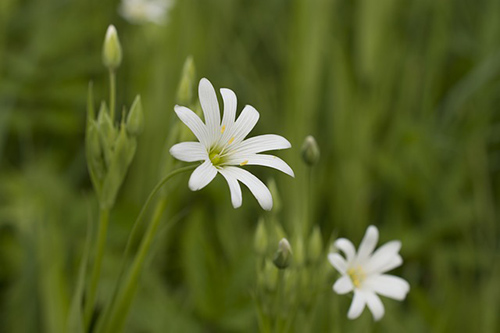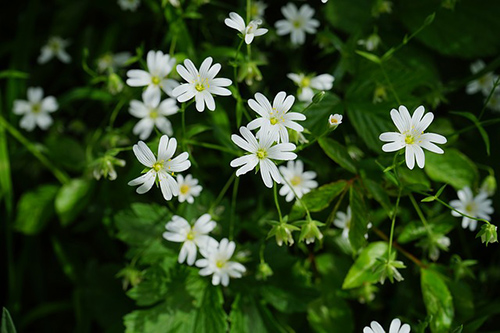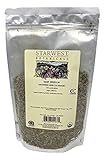Contents
The humble chickweed plant is highly appreciated by birds and poultry and by those who know nature and the gifts it offers human beings. Chickweed grows small leaves from its young stems when the pastures become green in early spring. This is the right time to gather the plants and prepare tasty salads. Some people cook it like spinach. Raw or cooked, chickweed does not have a sour or hot flavor, being quite similar to cultivated vegetables in taste.
- CHICKWEED: Abundant traditional herb with naturally occurring bioflavonoid plant compounds
- TRADITIONAL FORMULA: The equivalent of 1,000 mg of Chickweed in each quick-release capsule
Chickweed was mentioned by the great Greek physician, pharmacologist, botanist, and author Pedanius Dioscorides in the 1st century A.D., though its properties were not well-known until the last century. Sebastian Kneipp, the renowned master of German natural medicine, used this plant successfully in afflictions of the respiratory airways.

Chickweed Plant Scientific Facts
- Other names: Adder’s mouth, Indian chickweed, satin flower, starwort, stitchwort, tongue-grass, winterweed.
- French: Stellaire.
- Spanish: Alsine.
- Environment: It is spread worldwide and usually grows in humid soils. Farmers consider this plant a weed in cultivated lands.
- Description: This is a plant of the Cariofilaceae family. It has weak stems, oval-shaped, peak-tipped leaves, and small star-shaped white flowers that open at noon.
- Parts of the plant used medicinally: The whole plant.

Healing Properties and Indications
The whole plant is rich in mineral salts and trace elements (especially magnesium, phosphorus, silicon, potassium, iron, and copper), as well as in B vitamins and vitamin C. Chickweed also contains a certain amount of saponins (from the Greek saponem, soap), which are substances that decrease the surface tension of water, producing foam-like soap. In the mucous membranes of the body, the saponins cause the formation of a fine, long-lasting foam.
The saponins are the most important active components of chickweed. Most of the properties of this plant are due to these substances.

- Expectorant: It eliminates dry or thick secretions in bronchitis and simple bronchial catarrh.
- Emollient: It is used with gastritis to protect the stomach mucous membrane and alleviate the heavy sensation associated with this disorder. With colitis (inflammation of the large intestine), it is used to favor a regular, painless evacuation since it has a mild laxative effect.
- In external applications, chickweed eliminates the skin inflammation caused by bruises, irritations caused by physical reasons (sunburns, etc.), or chemical ones (toxic substances, etc.).
- Invigorating: Due to its mineral salts and vitamins content, chickweed naturally stimulates the whole body, producing a sense of well-being and vitality. It is beneficial for fatigue or exhaustion.
This plant is a common weed that is very valuable for treating fevers, blood toxicity, inflammations, and other “hot” diseases. Chickweed is known to relieve nasal congestion. It is helpful for hoarseness, skin diseases, coughs, colds, bowel inflammation, circulatory problems, pleurisy, and bronchitis. This herb is mild, as safe as any garden vegetable, and contains vitamins and minerals. Most people usually eat it as a salad green. Therefore, it is okay to use in high dosages.
Chickweed lowers blood lipids, so it is beneficial in reducing excess fat thanks to its mild laxative and diuretic properties. Drinking its tea helps to build blood. The plant can also be applied as a poultice to abscesses, boils, and warts. It can also be used for various skin diseases and sores when made into an oil and ointment.
Adding chickweed plant tea to a bath helps soothe skin irritations and rashes. It is also used as a salve for itchy and dry skin, and it is also used for mouth sores. In Europe, it is used as a cooling expectorant and demulcent to relieve coughs, skin diseases, and itching.
How to use Chickweed
- Raw in salads or cooked like spinach.
- Decoction
- Poultices
Infusion: Steep for five to fifteen minutes. Take 6 ounces three to four times daily between meals. Decoction: One ounce to 1 ½ pint boiling water, simmered to one pint. Take three ounces three to four times every two to three hours when needed. Tincture: Take ½ teaspoon as needed. Fluid Extract: Take ½ to one teaspoon as needed. Powder: Take five to ten #0 capsules (30 to 60 grains) thrice daily.
DISCLAIMER: All content on this website is presented solely for educational and informational objectives. Do not rely on the information provided as a replacement for advice, diagnosis, or treatment from a qualified medical expert. If you are pregnant, nursing, or have any preexisting medical concerns, talk to your doctor before using any herbal or natural medicines.
REFERENCES
- George D. Pamplona-Roger, M.D. “Encyclopedia of Medicinal Plants.” George D. Pamplona-Roger, M.D. Encyclopedia of Medicinal Plants. Ed. Francesc X. Gelabert. Vols. 1 San Fernando de Henares: Editorial Safeliz, 2000. 334, 335. Print. [chickweed plant]
- Vance Ferrell Harold M. Cherne, M.D. The Natural Remedies Encyclopedia [Book]. – Altamont, TN: Harvestime Books, 2010. – Vol. Seventh Edition: 7: pp. 152.
- https://www.webmd.com/vitamins/ai/ingredientmono-622/chickweed
- https://www.verywellhealth.com/chickweed-what-should-i-know-about-it-89437
Last update on 2025-06-04 / Affiliate links / Images from Amazon Product Advertising API





